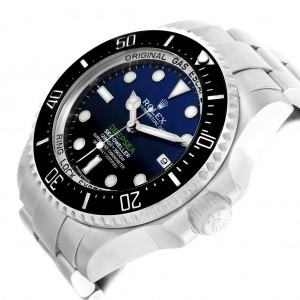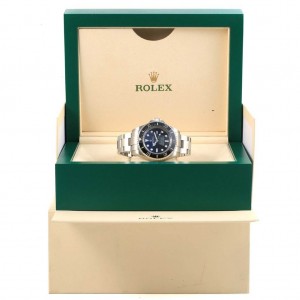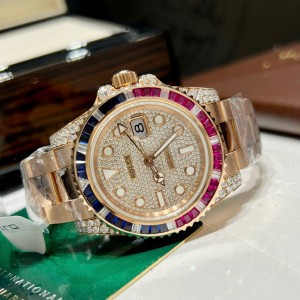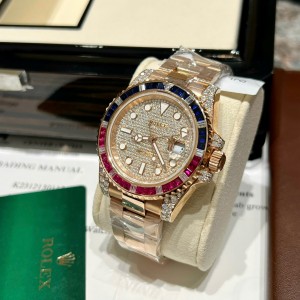Nigel Band, a professional diver with over three decades of experience in both commercial and teaching capacities, holds two unique Rolex watches – each with a remarkable history of its own. These watches have not only been part of his personal journey but have also accompanied him through some of the most extreme conditions imaginable. 
A Tool for Deep-Sea Diving
One of Band’s prized watches is a 1986 Rolex Sea-Dweller Reference 16660, also known as the “triple-six.” This model is far from the type of watch that’s often seen gathering dust in the drawers of office workers – Band’s Sea-Dweller has been actively used in some of the most demanding environments in the world. Unlike many dive watches, which remain confined to domestic sinks and showers, Band’s Sea-Dweller has been part of his deep-sea diving operations, where it endured the extreme pressures of saturation diving.
Saturation diving, a technique developed in the 1960s to support offshore oil drilling, involves divers working at depths of hundreds of meters for prolonged periods. The divers breathe a mixture of helium and oxygen and live under high pressure for weeks at a time. Band’s Sea-Dweller, worn during over 20 years of such diving operations, has a depth rating of 1,220 meters, a testament to its robustness. In the harsh and corrosive environment of the deep ocean, the watch has earned its place as a true tool of the trade, not merely a luxury accessory.
A Watch that Scaled the Heights
The second of Band’s noteworthy Rolex watches is a 1952 Oyster Perpetual, a model with significant historical value. This particular watch doesn’t have a legacy linked to the deep oceans, but rather to the world’s highest peaks – specifically, Mount Everest. Band’s father, George Band, was the youngest member of the historic 1953 Everest expedition, led by Sir John Hunt. As a member of the team that first reached the summit, George’s Rolex Oyster Perpetual, engraved with “EVEREST 1953,” became part of mountaineering lore.
Growing up, Nigel was surrounded by stories of Himalayan expeditions and the rugged adventures of his father and other Everest climbers. In his youth, he often rubbed shoulders with mountaineering legends such as Sir Edmund Hillary and Tenzing Norgay. Yet despite this fascinating family legacy, Nigel’s path led him to the depths of the ocean, where he found his own calling as a commercial diver. 
How Band Became a Diver
Nigel Band’s career in diving began somewhat serendipitously. As the son of an oil executive, his childhood was filled with international travel. By the age of 15, Band had already lived in five different countries, shaping his adventurous spirit. But it was a conversation with his father in London that ultimately steered him towards a career in diving.
After a family discussion about his future, during which it became clear that university wasn’t in the cards, Nigel’s father suggested, “Well, you can always become a diver.” Although his father’s comment might have seemed dismissive, it struck a chord with Band, who had always felt more at home in the water than on dry land. His childhood in Oman had already seen him snorkeling with friends every day after school instead of playing soccer like his peers. This connection to the sea was undeniable.
At 18, Band was rejected from a formal diving course due to his age, but his determination led him to secure an apprenticeship on an oil services barge in the Far East. He quickly found himself working alongside veterans of the Vietnam War, diving in one of the most dangerous and physically demanding professions.
A Rolex Sea-Dweller Earned Through Hard Work
By 1986, Band was ready to purchase a replica Rolex Sea-Dweller, but not without some resistance. At the time, he was still a young diver and was advised by a colleague to wait until he had completed his first saturation dive. Despite the discouragement, Band persisted, eventually buying the watch for £680 at Schiphol Airport on his way home from a job in the Middle East. His appearance – a casual 23-year-old in jeans and flip-flops – must have raised a few eyebrows at the Rolex retailer.
Yet Band’s Sea-Dweller wasn’t just a status symbol. It was a tool for survival. Saturation diving, unlike traditional scuba diving, involves living under pressure for weeks at a time. This lifestyle requires not just physical endurance but also the mental fortitude to work in dark, often hazardous underwater environments, relying on equipment such as a full diving helmet connected to a surface vessel.
The Sea-Dweller’s Unique Qualities
The Rolex Sea-Dweller was designed with the needs of saturation divers in mind. Unlike other dive watches, which might struggle under extreme pressure, the Sea-Dweller is equipped with a helium release valve. This ensures that helium, which can build up inside the case during deep dives, is safely released during the ascent, preventing the crystal from popping off. This was crucial for Band, whose Sea-Dweller endured countless dives in extreme conditions.
As time passed, Band’s Sea-Dweller began to show signs of wear. After years of exposure to the harsh underwater environment, the watch required servicing. Rolex replaced the corroded hands, and over the years, the watch’s bezel underwent several replacements due to repeated helium exposure, which caused it to “ghost” to a light grey. However, Band remained unfazed by the loss in potential value, as the watch’s function as a reliable tool for diving was far more important to him than its collector value.
The Satirical Game of “Watch Conkers”
Band’s time as a commercial diver was not all about serious work. As divers spent long hours in decompression or waiting for their next dive, they often found creative ways to pass the time. One such pastime, invented by Band, was a game called “Watch Conkers.” This game involved using dive watches to take swings at each other, in a playful test of durability. Band’s Seiko 150 proved unbreakable in this game, eventually defeating a fellow diver’s Rolex in a highly entertaining fashion.
George Band’s Role in Everest History
George Band’s legacy as a mountaineer is indelibly tied to his participation in the 1953 Everest expedition. Not only did he play a pivotal role in the team’s success, but he also carried with him a Rolex Oyster Perpetual, a watch that has become part of Everest lore. Over the years, George’s mountaineering achievements, including the 1955 conquest of Kangchenjunga, have made him a key figure in the history of Himalayan exploration. 
The Importance of Maintenance
Nigel Band’s respect for the significance of both his Sea-Dweller and his father’s Oyster Perpetual is evident in his careful maintenance of both watches. He understands that these watches are not just valuable artifacts – they are functional tools that served a specific purpose at a particular point in history. His father’s Oyster Perpetual, still on its original Fixoflex bracelet, holds both sentimental and historical value. As for his Sea-Dweller, while it may have required servicing over the years, it continues to serve its original purpose, a testament to the Rolex commitment to durability and precision.
The Enduring Legacy of Rolex
Both of Nigel Band’s Rolex watches – the Sea-Dweller and the Oyster Perpetual – are more than just watches. They are symbols of extreme endurance, of pushing the limits of human achievement both underwater and on land. From the depths of the ocean to the heights of Everest, these watches have played a crucial role in some of the most daring adventures ever undertaken. Through the years, Band’s story has intertwined with these iconic pieces, forging a legacy of exploration and survival that will endure for generations to come.
